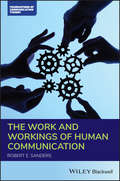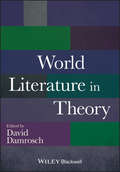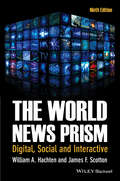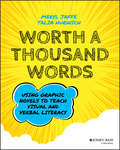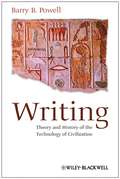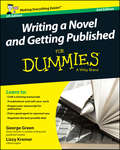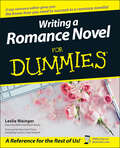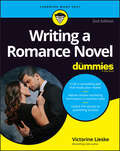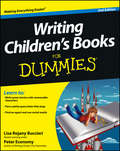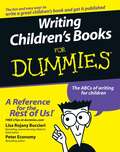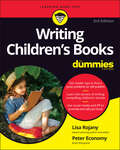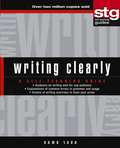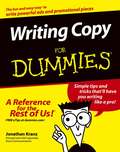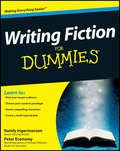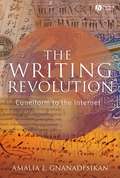- Table View
- List View
The Work and Workings of Human Communication (Foundations of Communication Theory Series)
by Robert E. SandersDiscover the fundamentals of human communication with this comprehensive and insightful resource Written in four sections, The Work and Workings of Human Communication identifies the underlying fundamentals that make our communication distinctively human. These fundamentals are the common ground that tie together the many topics and subject matters covered by the study and discipline of communication. They are also the basis of the unique contribution of the communication discipline to the social sciences. Professor, researcher and theorist Robert E. Sanders starts by focusing on what is unique about human communication and moves on to an examination of the complexities of scientific inquiry in the social sciences in general and in the communication discipline specifically. At the heart of the matter is the fact that humans are thinking beings who can make choices and therefore are not entirely predictable. This points towards new topics and questions that are likely to arise as the discipline evolves. Sanders’ approach leads to recognition of the fact that communication is at the center of how humans build our ways of life and participate together. By focusing on the underlying fundamentals that give rise to the discipline’s topics and subject areas, The Work and Workings of Human Communication encourages students to engage in independent thought about what they want to contribute by: Emphasizing the importance of communication in creating, sustaining or changing—and participating in—our ways of life on an interpersonal level and on a societal level Recognizing that human communication is inherently collaborative; people affect situations by interacting with others, not acting on others Explaining the history, current agendas and possible future of the social science side of the Communication discipline A perfect resource for new graduate students in introductory communication courses who have an interest in the social science side of the discipline, The Work and Workings of Human Communication is also highly valuable for undergraduate communication and liberal arts students who don’t possess a background in the discipline.
The Work and Workings of Human Communication (Foundations of Communication Theory Series)
by Robert E. SandersDiscover the fundamentals of human communication with this comprehensive and insightful resource Written in four sections, The Work and Workings of Human Communication identifies the underlying fundamentals that make our communication distinctively human. These fundamentals are the common ground that tie together the many topics and subject matters covered by the study and discipline of communication. They are also the basis of the unique contribution of the communication discipline to the social sciences. Professor, researcher and theorist Robert E. Sanders starts by focusing on what is unique about human communication and moves on to an examination of the complexities of scientific inquiry in the social sciences in general and in the communication discipline specifically. At the heart of the matter is the fact that humans are thinking beings who can make choices and therefore are not entirely predictable. This points towards new topics and questions that are likely to arise as the discipline evolves. Sanders’ approach leads to recognition of the fact that communication is at the center of how humans build our ways of life and participate together. By focusing on the underlying fundamentals that give rise to the discipline’s topics and subject areas, The Work and Workings of Human Communication encourages students to engage in independent thought about what they want to contribute by: Emphasizing the importance of communication in creating, sustaining or changing—and participating in—our ways of life on an interpersonal level and on a societal level Recognizing that human communication is inherently collaborative; people affect situations by interacting with others, not acting on others Explaining the history, current agendas and possible future of the social science side of the Communication discipline A perfect resource for new graduate students in introductory communication courses who have an interest in the social science side of the discipline, The Work and Workings of Human Communication is also highly valuable for undergraduate communication and liberal arts students who don’t possess a background in the discipline.
World Literature in Theory
by David DamroschWorld Literature in Theory provides a definitive exploration of the pressing questions facing those studying world literature today. Coverage is split into four parts which examine the origins and seminal formulations of world literature, world literature in the age of globalization, contemporary debates on world literature, and localized versions of world literature Contains more than 30 important theoretical essays by the most influential scholars, including Johann Wolfgang von Goethe, Hugo Meltzl, Edward Said, Franco Moretti, Jorge Luis Borges, and Gayatri Spivak Includes substantive introductions to each essay, as well as an annotated bibliography for further reading Allows students to understand, articulate, and debate the most important issues in this rapidly changing field of study
World Literature in Theory
by David DamroschWorld Literature in Theory provides a definitive exploration of the pressing questions facing those studying world literature today. Coverage is split into four parts which examine the origins and seminal formulations of world literature, world literature in the age of globalization, contemporary debates on world literature, and localized versions of world literature Contains more than 30 important theoretical essays by the most influential scholars, including Johann Wolfgang von Goethe, Hugo Meltzl, Edward Said, Franco Moretti, Jorge Luis Borges, and Gayatri Spivak Includes substantive introductions to each essay, as well as an annotated bibliography for further reading Allows students to understand, articulate, and debate the most important issues in this rapidly changing field of study
The World News Prism: Digital, Social and Interactive
by William A. Hachten James F. ScottonNow available in a fully revised and updated ninth edition, World News Prism provides in-depth analysis of the changing role of transnational news media in the 21st-century. Includes three new chapters on Russia, Brazil, and India and a revised chapter on the Middle East written by regional media experts Features comprehensive coverage of the growing impact of social media on how news is being reported and received Charts the media revolutions occurring throughout the world and examines their effects both locally and globally Surveys the latest developments in new media and forecasts future developments
The World News Prism: Digital, Social and Interactive
by William A. Hachten James F. ScottonNow available in a fully revised and updated ninth edition, World News Prism provides in-depth analysis of the changing role of transnational news media in the 21st-century. Includes three new chapters on Russia, Brazil, and India and a revised chapter on the Middle East written by regional media experts Features comprehensive coverage of the growing impact of social media on how news is being reported and received Charts the media revolutions occurring throughout the world and examines their effects both locally and globally Surveys the latest developments in new media and forecasts future developments
Worth A Thousand Words: Using Graphic Novels to Teach Visual and Verbal Literacy
by Meryl Jaffe Talia HurwichUse graphic novels to teach visual and verbal literacy While our kids today are communicating outside the classroom in abbreviated text bursts with visual icons, teachers are required to teach them to critically listen, think, and read and write complex texts. Graphic novels are a uniquely poised vehicle we can use to bridge this dissonance between student communication skills and preferences with mandated educational goals. Worth a Thousand Words details how and why graphic novels are complex texts with advanced-level vocabulary, and demonstrates how to read and analyze these texts. It includes practical advice on how to integrate these books into both ELA and content-area classrooms and provides an extensive list of appropriate graphic novels for K-8 students, lesson suggestions, paired graphic/prose reading suggestions, and additional resources for taking these texts further. Provides research to back up why graphic novels are such powerful educational tools Helps you engage diverse student learners with exciting texts Shows you how to make lessons more meaningful Offers advice on implementing new literary mediums into your classroom Perfect for parents and teachers in grades K-8, Worth a Thousand Words opens up an exciting new world for teaching children visual and verbal literacy.
Worth A Thousand Words: Using Graphic Novels to Teach Visual and Verbal Literacy
by Meryl Jaffe Talia HurwichUse graphic novels to teach visual and verbal literacy While our kids today are communicating outside the classroom in abbreviated text bursts with visual icons, teachers are required to teach them to critically listen, think, and read and write complex texts. Graphic novels are a uniquely poised vehicle we can use to bridge this dissonance between student communication skills and preferences with mandated educational goals. Worth a Thousand Words details how and why graphic novels are complex texts with advanced-level vocabulary, and demonstrates how to read and analyze these texts. It includes practical advice on how to integrate these books into both ELA and content-area classrooms and provides an extensive list of appropriate graphic novels for K-8 students, lesson suggestions, paired graphic/prose reading suggestions, and additional resources for taking these texts further. Provides research to back up why graphic novels are such powerful educational tools Helps you engage diverse student learners with exciting texts Shows you how to make lessons more meaningful Offers advice on implementing new literary mediums into your classroom Perfect for parents and teachers in grades K-8, Worth a Thousand Words opens up an exciting new world for teaching children visual and verbal literacy.
Writing: Theory and History of the Technology of Civilization
by Barry B. PowellWriting: Theory and History of the Technology of Civilization traces the origins of writing tied to speech from ancient Sumer through the Greek alphabet and beyond. Examines the earliest evidence for writing in Mesopotamia in the fourth millennium BC, the origins of purely phonographic systems, and the mystery of alphabetic writing Includes discussions of Ancient Egyptian,Chinese, and Mayan writing Shows how the structures of writing served and do serve social needs and in turn create patterns of social behavior Clarifies the argument with many illustrations
Writing: Theory and History of the Technology of Civilization
by Barry B. PowellWriting: Theory and History of the Technology of Civilization traces the origins of writing tied to speech from ancient Sumer through the Greek alphabet and beyond. Examines the earliest evidence for writing in Mesopotamia in the fourth millennium BC, the origins of purely phonographic systems, and the mystery of alphabetic writing Includes discussions of Ancient Egyptian,Chinese, and Mayan writing Shows how the structures of writing served and do serve social needs and in turn create patterns of social behavior Clarifies the argument with many illustrations
Writing a Novel and Getting Published For Dummies UK
by George Green Lizzy E. KremerLearn to: Craft a winning manuscript Troubleshoot and edit your work Prepare your manuscript for publication Find a good agent to represent you Negotiate the best possible deal Turn your aspiration into reality with this completely updated guide If you’ve always wanted to write that great novel, but never knew where to start, look no further! With a published author advising you on how to write well and a literary agent providing insight into getting a publishing deal, this updated guide gives you the inside track on the art and science of breaking into the fiction-publishing industry. Taking you step by step from concept to contract, this book provides the tools you need to tell your story with skill and approach agents and publishers with confidence. Dive in — check out how to combine your natural talent with the writing techniques used by successful authors Establish a firm foundation — construct your basic story, plot and structure Examine the key elements — create characters, develop dialogue, explore relationships and insert conflict Fine-tune and finish up — discover tips on adding detail, creativity and flair while bringing your work to a close Get published — take the next step by weighing up your publishing options, working with agents and negotiating deals Find out more — check out additional advice, like the most common mistakes you need to avoid, and tips from published authors Open the book and find: Tips for getting started Creative ways to develop plots, storylines, characters and dialogue The seven basic stories and how to put them to work Tricks for crafting a great ending to your novel How to prepare your manuscript for editing and publishing The lowdown on the business side of publishing
Writing a Novel and Getting Published For Dummies UK
by George Green Lizzy E. KremerLearn to: Craft a winning manuscript Troubleshoot and edit your work Prepare your manuscript for publication Find a good agent to represent you Negotiate the best possible deal Turn your aspiration into reality with this completely updated guide If you’ve always wanted to write that great novel, but never knew where to start, look no further! With a published author advising you on how to write well and a literary agent providing insight into getting a publishing deal, this updated guide gives you the inside track on the art and science of breaking into the fiction-publishing industry. Taking you step by step from concept to contract, this book provides the tools you need to tell your story with skill and approach agents and publishers with confidence. Dive in — check out how to combine your natural talent with the writing techniques used by successful authors Establish a firm foundation — construct your basic story, plot and structure Examine the key elements — create characters, develop dialogue, explore relationships and insert conflict Fine-tune and finish up — discover tips on adding detail, creativity and flair while bringing your work to a close Get published — take the next step by weighing up your publishing options, working with agents and negotiating deals Find out more — check out additional advice, like the most common mistakes you need to avoid, and tips from published authors Open the book and find: Tips for getting started Creative ways to develop plots, storylines, characters and dialogue The seven basic stories and how to put them to work Tricks for crafting a great ending to your novel How to prepare your manuscript for editing and publishing The lowdown on the business side of publishing
Writing a Romance Novel For Dummies
by Leslie WaingerIn love with romance novels? You’re not alone! Romance is today’s most popular fiction genre, accounting for more than half of all mass market fiction sold. If you’re looking to make a serious effort at writing a romance and getting it published in today’s multifaceted markets, you need to learn as much as you can about this highly successful field—especially how to create the perfect heroes and heroines. Now, in this easy, step-by-step guide, a top romance editor gives you the know-how you need to succeed as a romance novelist! Writing A Romance Novel For Dummies is perfect for both beginning and more accomplished writers who are looking to get the leading edge on writing a romance novel and get it published. Leslie Wainger, Executive Editor at Harlequin Books, explains what it takes to become the next Nora Roberts, providing the techniques you need to: Select a pseudonym Write a compelling, heartfelt story Find the right agent and publisher Submit a manuscript Market your novel Join clubs and associations Packed with insider advice, this plain-English guide helps you grasp the building blocks of a great romance, providing practical tips on the craft of writing as well as savvy pointers on how to hook your reader from page one, write with passion, and shape a proposal that will wow agents and editors. You get lots of expert tips on analyzing the marketplace, creating compelling characters, and finding your own voice. Wainger also: Demystifies the sub-genres of the romance world, from historical, contemporary, and multicultural to paranormal, romantic suspense, and Christian/inspirational Explains plotting, pacing, and writing those crucial love scenes Discusses how to conduct research, assign credits, and get permissions Helps you decide whether it’s best to write alone or with a partner Complete with a manuscript preparation checklist, tips for revising your work smoothly and successfully, guidance in understanding and negotiating a contract, and a list of romance writing resources, Writing A Romance Novel For Dummies is your one-stop guide to becoming a published novelist!
Writing a Romance Novel For Dummies
by Leslie Wainger Victorine LieskeGet your romance (writing) on! Writing a Romance Novel For Dummies is the only reference aspiring writers need to get their careers off to the right start. Fully updated to reflect the industry's latest trends and secrets, this book helps you understand what makes a great novel, so you can hone your craft and write books people want to read. We break down the romance subgenres, give you expert tips on plotting and pacing, and walk you through the process of finding an agent and getting published in today’s competitive market—or self-publishing like many six-figure authors are doing. For aspiring writers longing to find success in the industry, Writing a Romance Novel For Dummies is easy to read, highly informative, and a must-have! Refine your writing to craft engaging stories readers can’t put down Find a route to publication that works for you—mainstream, or self-published Understand the ins and outs of the romance genre and its subgenres Learn how to get your work noticed in the popular world of romantic fiction This Dummies guide is perfect for beginning writers who want advice on writing and publishing a successful romance novel. It’s also a great reference for accomplished writers looking to level up their romance game.
Writing a Romance Novel For Dummies
by Leslie Wainger Victorine LieskeGet your romance (writing) on! Writing a Romance Novel For Dummies is the only reference aspiring writers need to get their careers off to the right start. Fully updated to reflect the industry's latest trends and secrets, this book helps you understand what makes a great novel, so you can hone your craft and write books people want to read. We break down the romance subgenres, give you expert tips on plotting and pacing, and walk you through the process of finding an agent and getting published in today’s competitive market—or self-publishing like many six-figure authors are doing. For aspiring writers longing to find success in the industry, Writing a Romance Novel For Dummies is easy to read, highly informative, and a must-have! Refine your writing to craft engaging stories readers can’t put down Find a route to publication that works for you—mainstream, or self-published Understand the ins and outs of the romance genre and its subgenres Learn how to get your work noticed in the popular world of romantic fiction This Dummies guide is perfect for beginning writers who want advice on writing and publishing a successful romance novel. It’s also a great reference for accomplished writers looking to level up their romance game.
Writing Children's Books For Dummies
by Lisa Rojany Buccieri Peter EconomyEverything aspiring authors need to write, publish, and sell a children's book Everyone loves a children's book—and many dream about writing one. But is it actually possible for an unpublished writer—armed with a good story idea and a love of kids—to write, sell, publish, and promote a book? Yes, it is! Clearly and concisely written with straightforward advice and a plethora of specific up-to-date recommendations, Writing Children's Books For Dummies provides step-by-step information on everything aspiring children's book authors need to know—from researching the current marketplace to developing story ideas, strengthening writing skills, dealing with editors, and submitting proposals and manuscripts to agents and publishers. Updated and improved writing exercises All new content on social media and establishing an online presence as an author Fresh, updated content on publishing via hard copy and all the e- platforms From setting down that first word on paper to doing a successful publicity tour, Writing Children's Books For Dummies gives you the confidence and the insiders' know-how to write and sell the story you've always wanted to write.
Writing Children's Books For Dummies
by Lisa Rojany Buccieri Peter EconomyEveryone loves a children's book. And many dream about writing one. But is it actually possible for an unpublished writer—armed with a good story idea and a love of kids—to write, sell, publish, and promote a book? Yes, it is! Veteran children's book publishing executive and author Lisa Rojany Buccieri and author Peter Economy show you how, in their incredibly useful 2005 first edition of Writing Children's Books For Dummies®. Buccieri and Economy begin by explaining the basics of the children's book business, from the nuts and bolts of the various formats and genres—with helpful illustrations to aid you—to the intricacies of the book publishing market, a list of recent award-winning books, and a first peek into the particular mind set that writing children's books requires. (Hint: Throw out the adult rules, and think like a kid!) Then the authors dive into the actual writing process itself, with tips on setting up a workspace, brainstorming great book ideas, researching the subject you decide on, even speaking with the sorts of kids you hope will eventually read the book. They show you how to create compelling characters and develop them in the manuscript; how to outline and write a plot "arc" of conflict, change, and resolution; how to master the difficult art of writing dialogue; and how to use active (rather than passive) language to keep your story moving along and interesting to young minds. Or, if you're planning to write a creative nonfiction children's book—on a topic such as science, nature, or a historical figure, for example—the authors include a chapter on this, too. Ready, set, go… it's time to sit down and write! Once you've finished your book, however, the process has only begun. Now you will refine, submit, and hopefully sell your manuscript. Here again, the authors of Writing Children's Books For Dummies come through for you. They deliver solid advice on hiring an illustrator—or not; participating in workshops and conferences to learn the business and hone a story; finding an agent; and, finally, submitting the manuscript to publishers and—if you are successful—signing a contract. Along the way, the authors also include tips on handling rejection; a quick primer on the various editors in publishing houses (and how they work to make your book its best); and making a plan to publicize the book, including hiring a publicist if necessary. Like all For Dummies® books, Writing Children's Books For Dummies highlights "The Part of Tens," which includes the Ten Best Ways to Promote Your Story and More Than Ten Great Sources for Storylines. And the ever-helpful Cheat Sheet includes Tips for Editing your Children's Book Manuscript, Children's Book No-No's, Twelve Commandments for Writing Younger Children's Books, and Tips on Promotion. From setting down that first word on paper to doing a successful publicity tour, Writing Children's Books For Dummies gives you the confidence and the insiders' know-how to write and sell the story you've always wanted to write.
Writing Children's Books For Dummies
by Lisa Rojany Buccieri Peter EconomyEverything aspiring authors need to write, publish, and sell a children's book Everyone loves a children's book—and many dream about writing one. But is it actually possible for an unpublished writer—armed with a good story idea and a love of kids—to write, sell, publish, and promote a book? Yes, it is! Clearly and concisely written with straightforward advice and a plethora of specific up-to-date recommendations, Writing Children's Books For Dummies provides step-by-step information on everything aspiring children's book authors need to know—from researching the current marketplace to developing story ideas, strengthening writing skills, dealing with editors, and submitting proposals and manuscripts to agents and publishers. Updated and improved writing exercises All new content on social media and establishing an online presence as an author Fresh, updated content on publishing via hard copy and all the e- platforms From setting down that first word on paper to doing a successful publicity tour, Writing Children's Books For Dummies gives you the confidence and the insiders' know-how to write and sell the story you've always wanted to write.
Writing Children's Books For Dummies
by Lisa Rojany Peter EconomyCreate the next very hungry caterpillar, big red dog, or cat in the hat with a hand from this trusted guide In Writing Children’s Books For Dummies, you’ll learn what to write between “Once upon a time . . .” and “The End” as you dive into chapters about getting started writing, how to build great characters, and how to design a dramatic plot. On top of the technical writing advice, you’ll discover how talented illustrators work and how to find an agent. The newest edition of this popular For Dummies title even shows you how to choose a publisher—or self-publish—and how to use social media and other marketing and PR to get the word out about your new masterpiece. In the book, you’ll learn about: The fundamentals of writing for children, including common book formats and genres, and the structure of the children’s book market Creating a spellbinding story with scene description, engaging dialogue, and a child-friendly tone Polishing your story to a radiant shine with careful editing and rewriting Making the choice between a traditional publisher, a hybrid publisher, or self-publishing Using the most-effective marketing and publicity techniques to get your book noticed Perfect for anyone who’s ever dreamed of creating the next Ferdinand the Bull or Grinch, Writing Children’s Books For Dummies is an essential, easy-to-read guide for budding children’s authors everywhere.
Writing Children's Books For Dummies
by Lisa Rojany Peter EconomyCreate the next very hungry caterpillar, big red dog, or cat in the hat with a hand from this trusted guide In Writing Children’s Books For Dummies, you’ll learn what to write between “Once upon a time . . .” and “The End” as you dive into chapters about getting started writing, how to build great characters, and how to design a dramatic plot. On top of the technical writing advice, you’ll discover how talented illustrators work and how to find an agent. The newest edition of this popular For Dummies title even shows you how to choose a publisher—or self-publish—and how to use social media and other marketing and PR to get the word out about your new masterpiece. In the book, you’ll learn about: The fundamentals of writing for children, including common book formats and genres, and the structure of the children’s book market Creating a spellbinding story with scene description, engaging dialogue, and a child-friendly tone Polishing your story to a radiant shine with careful editing and rewriting Making the choice between a traditional publisher, a hybrid publisher, or self-publishing Using the most-effective marketing and publicity techniques to get your book noticed Perfect for anyone who’s ever dreamed of creating the next Ferdinand the Bull or Grinch, Writing Children’s Books For Dummies is an essential, easy-to-read guide for budding children’s authors everywhere.
Writing Clearly: A Self-Teaching Guide (Wiley Self-Teaching Guides #160)
by Dawn SovaImprove your writing skills at your own pace How do you target a specific audience in writing? What makes up a strong thesis statement? Is there a trick to maintaining clear communication in cyberspace? How do you achieve unity and coherence in a final draft? With Writing Clearly: A Self-Teaching Guide, you'll discover the answers to these questions and many more about the basics of communicating effectively through the written word. Each chapter in this hands-on guide focuses on key steps in the writing process, identifying the shared and differing skills demanded by each type of writing, be it a persuasive essay, a business letter, or a scientific report. The straightforward, structured format of Writing Clearly makes it fully accessible, providing an easy-to-understand, comprehensive overview for everyone-from students beginning to build skills, to adults looking to improve their writing, to the experienced writer hoping to further hone skills in a certain area. Like all Self-Teaching Guides, Writing Clearly allows you to build gradually on what you have learned-at your own pace. Questions and self-tests reinforce the information in each chapter and allow you to skip ahead or focus on specific areas of concern. Packed with useful, up-to-date information, this clear, concise volume is a valuable learning tool and reference source for anyone who wants to develop or improve his or her basic writing skills.
Writing Copy For Dummies (For Dummies)
by Jonathan KranzTips on writing to consumers and business-to-business Create captivating, results-oriented, sales-generating copy Need to produce winning copy for your business? This fast, fun guide takes you through every step of a successful copywriting project, from direct mail, print ads, and radio spots to Web sites, articles, and press releases. You'll see how to gather crucial information before you write, build awareness, land sales, and keep customers coming back for more. Discover How To: * Write compelling headlines and body copy * Turn your research into brilliant ideas * Create motivational materials for worthy causes * Fix projects when they go wrong * Land a job as a copywriter
Writing Fiction For Dummies: A Science Fiction Suspense Novel
by Randy Ingermanson Peter EconomyA complete guide to writing and selling your novel So you want to write a novel? Great! That’s a worthy goal, no matter what your reason. But don’t settle for just writing a novel. Aim high. Write a novel that you intend to sell to a publisher. Writing Fiction for Dummies is a complete guide designed to coach you every step along the path from beginning writer to royalty-earning author. Here are some things you’ll learn in Writing Fiction for Dummies: Strategic Planning: Pinpoint where you are on the roadmap to publication; discover what every reader desperately wants from a story; home in on a marketable category; choose from among the four most common creative styles; and learn the self-management methods of professional writers. Writing Powerful Fiction: Construct a story world that rings true; create believable, unpredictable characters; build a strong plot with all six layers of complexity of a modern novel; and infuse it all with a strong theme. Self-Editing Your Novel: Psychoanalyze your characters to bring them fully to life; edit your story structure from the top down; fix broken scenes; and polish your action and dialogue. Finding An Agent and Getting Published: Write a query letter, a synopsis, and a proposal; pitch your work to agents and editors without fear. Writing Fiction For Dummies takes you from being a writer to being an author. It can happen—if you have the talent and persistence to do what you need to do.
Writing Fiction For Dummies
by Randy Ingermanson Peter EconomyA complete guide to writing and selling your novel So you want to write a novel? Great! That’s a worthy goal, no matter what your reason. But don’t settle for just writing a novel. Aim high. Write a novel that you intend to sell to a publisher. Writing Fiction for Dummies is a complete guide designed to coach you every step along the path from beginning writer to royalty-earning author. Here are some things you’ll learn in Writing Fiction for Dummies: Strategic Planning: Pinpoint where you are on the roadmap to publication; discover what every reader desperately wants from a story; home in on a marketable category; choose from among the four most common creative styles; and learn the self-management methods of professional writers. Writing Powerful Fiction: Construct a story world that rings true; create believable, unpredictable characters; build a strong plot with all six layers of complexity of a modern novel; and infuse it all with a strong theme. Self-Editing Your Novel: Psychoanalyze your characters to bring them fully to life; edit your story structure from the top down; fix broken scenes; and polish your action and dialogue. Finding An Agent and Getting Published: Write a query letter, a synopsis, and a proposal; pitch your work to agents and editors without fear. Writing Fiction For Dummies takes you from being a writer to being an author. It can happen—if you have the talent and persistence to do what you need to do.
The Writing Revolution: Cuneiform to the Internet (The Language Library)
by Amalia E. GnanadesikanIn a world of rapid technological advancements, it can be easy to forget that writing is the original Information Technology, created to transcend the limitations of human memory and to defy time and space. The Writing Revolution picks apart the development of this communication tool to show how it has conquered the world. Explores how writing has liberated the world, making possible everything from complex bureaucracy, literature, and science, to instruction manuals and love letters Draws on an engaging range of examples, from the first cuneiform clay tablet, Egyptian hieroglyphs, and Japanese syllabaries, to the printing press and the text messaging Weaves together ideas from a number of fields, including history, cultural studies and archaeology, as well as linguistics and literature, to create an interdisciplinary volume Traces the origins of each of the world’s major written traditions, along with their applications, adaptations, and cultural influences
